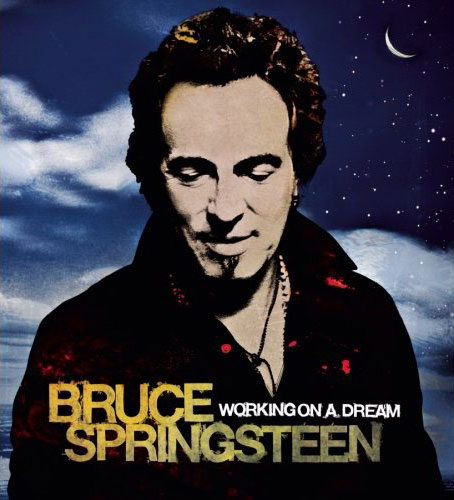
The cover to Working on a Dream. I know, right?
Bruce Springsteen once wrote a song called “I Wish I Were Blind.” The tune appears on Human Touch, easily the most reviled album in a recording career that goes back to 1973. Released in 1992, after a five-year drought of new music wherein Springsteen — gasp! — fired the E Street Band, Human Touch gave us The Boss at his Billy Joel-iest, a synthy, syrupy snoozefest that even die-hard Boss fans (Hi!) omit from their iTunes libraries.
But while Human Touch might be the worst Springsteen album to listen to, it’s far from the worst to look at. No, that dubious honor might have to go to The Boss’s imminent Working on a Dream, which officially arrives tomorrow (though it leaked online two weeks ago and has already been streamed via NPR’s website) wrapped in a velvet-Elvis style tableau that looks like something a member of the Backstreets staff paid an art teacher at Freehold Community College to paint on the side of his van.
That the album’s cheesy grill stands out as particularly egregious in the Springsteen oeuvre really says something, because it would be tough to find another musician with career album sales far north of the 100 million mark who has shown such consistently guileless aesthetic judgment when it comes to packaging. Many of the Boss’s releases would have looked better the way Bruce spent much of the 1984-5 Born in the U.S.A. Tour: sleeveless. Don’t believe me? Walk with me back through Boss-time; you’ll see. We’re including only albums that Springsteen (presumably) had some say in how they looked, so no bootlegs.
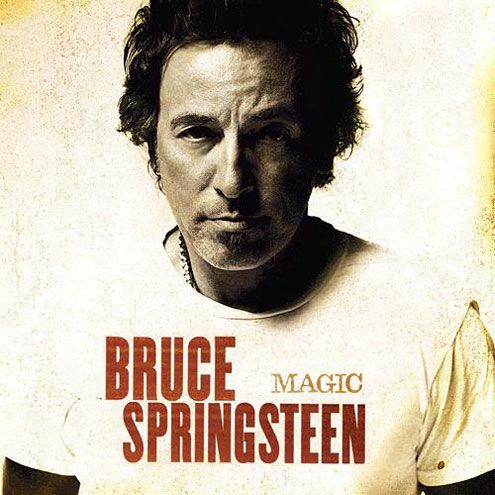
Magic (2007)
The canonical predecessor to Working on a Dream (released only 16 months before; an eyeblink in Bruce-time) employs sepia-toned Photoshoppery to get around the fact The Boss (who just has to have his mug on the cover, again) was 58 years old when this thing came out. The message? Seven years after George W. Bush came to power, the world is a coppery, piss-colored cloud.
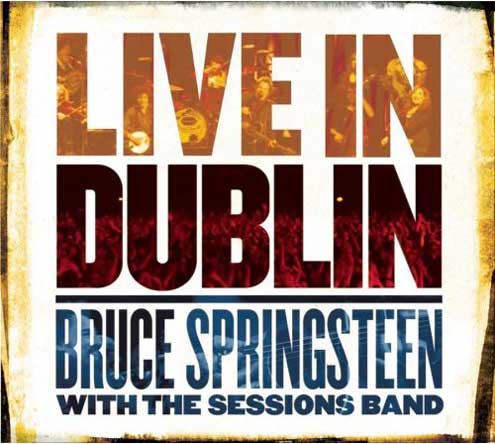
Live in Dublin (2007)
Here’s a no-frills cover that gets it done. The live album/DVD documenting Bruce’s surprisingly successful roadshow marriage of his boisterous live aesthetic to that of old-timey, pre-rock-and-roll folk and Nawlins jazz, suggests a Hatch Show Print-style handbill. This was the only tour (so far) on which Bruce was regularly seen taking shots of whiskey onstage. Curiously, it’s not one of the several album covers on which The Boss appears to be sporting a ’69-chevy-with-a-three-ninety-six hangover. (See: Darkness on the Edge of Town, The River, Devils and Dust.)
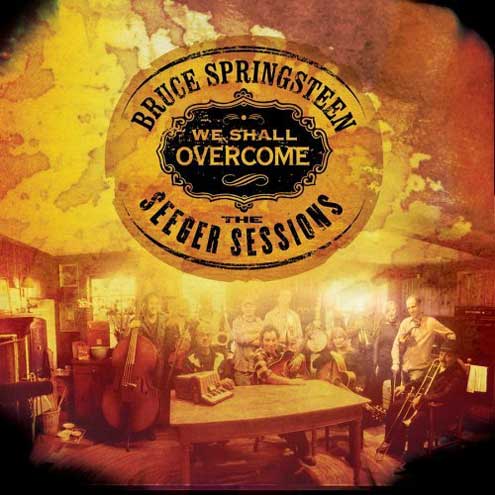
We Shall Overcome: The Seeger Sessions (2006)
Not nearly as exciting as Live in Dublin, this is an album recorded in four days over the course of ten years. The subtitle The Seeger Sessions is kind of a misnomer, as Seeger popularized many of these songs but wrote almost none of them. The cover is is a photo of the sprawling band Bruce assembled for these raucous sessions, dirtied up with that coppery-gold wash Bruce loves, suggestive of dust-bowl grit, with a logo that wouldn’t look out of place on a bottle of whiskey.
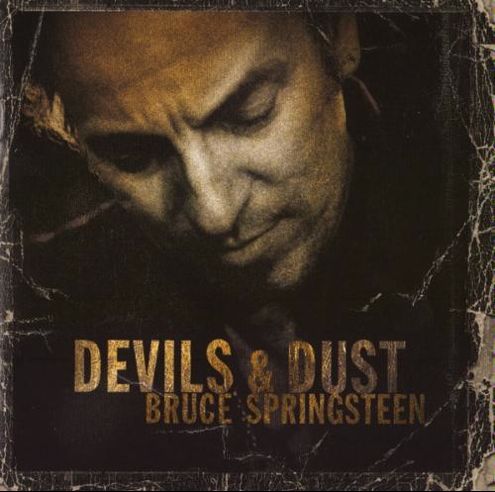
Devils and Dust (2005)
This solo-Bruce outing in the style, sort of, of Nebraska or The Ghost of Tom Joad, greets the world with an acid-washed image of Bruce wincing in pain, implying a more morose album than this ultimately is. Aside from the Iraq-set title track, these songs are rumored to have been sitting around since the late nineties.
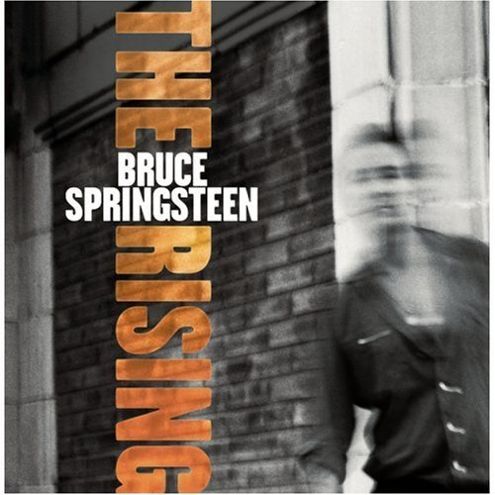
The Rising (2002)
On the People’s Glorious Don’t-Call-It-a-Reunion Tour of 1999-2000, Bruce introduced a number of top-shelf new songs written for the E Street Band, among them “American Skin (41 Shots)” and the show-closing anthem “Land of Hope and Dreams.” A new album with the E Street Band seemed certain swiftly to follow. In fact, it took two years — and the 9/11 attacks.
The Rising attempted nothing less than to bind our national wounds and to vest us with the strength to see our way safely through The Valley of the Shadow. Marketed (inaccurately) as the first E Street band album since 1984’s mega-selling Born in the U.S.A., The Rising swung for the fences and did a lot of things right. But its cover — a blurry, out-of-focus medium shot of a white guy whom we infer to be internationally famous rock star Bruce “The Boss” Springsteen, underneath the album’s almost-as-vague title rendered in fiery orange Impact font — was not among them.
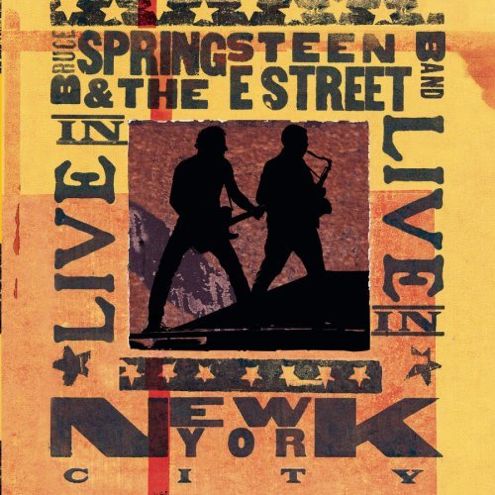
Live in New York City (2001)
Recorded on two nights at Madison Square Garden during the ten-night stand that closed the first E Street tour since 1988, this album did a pretty good job of capturing something of the grandeur and flow of a typical gig of this era, along with the superb new arrangements of many of the songs in the setlist. The cover is courtesy of Hatch Show Print, the great southern shop that made smart-looking posters for Elvis and Johnny Cash and pretty much everybody since. The depiction in silhouette of Bruce with the unmistakable Clarence “Big Man” Clemons is a callback to the iconic Born to Run cover 26 years earlier, instantly communicating that the E Street Band is back. Simple but effective.
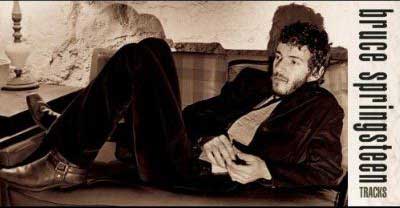 Tracks (1998)
Tracks (1998)
Springsteen has always been an artist of Prince-level prolificacy, holding back many more complete songs than he’s ever released. Much of the material that surfaced on Tracks had circulated among hard-core fans for decades prior to its sanctioned release in this four-disc, 66-song collection, but this was just the tip of the iceberg. There’s material from every phase of The Boss’s career here — the set opens with legendary A&R man John Hammond’s voice introducing Bruce’s 1972 demo of “Mary, Queen of Arkansas,” and ends with a couple of songs recorded with the E Street Band in 1995 as bonus tracks for that year’s Greatest Hits.
And how does Bruce chose to allude visually to this treasure trove of riches from every Boss era — even the wilderness of the early 90s? With a photo of himself reclining on the couch. If you weren’t already a fan, would seeing this make you want to sample this box set’s contents? I mean, not that a newbie would ever start here, but still.
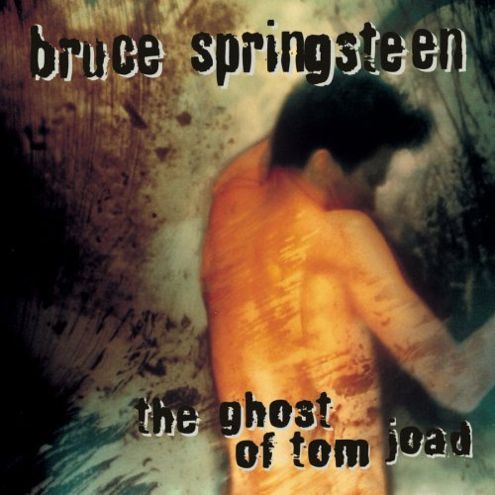
The Ghost of Tom Joad (1995)
A dusty, somber, E Street-free (though Roy Bittan is around) collection of ballads about twitchy ex-cons, conflicted border guards, and luckless Mexican immigrants, this one — named for the hero of John Steinbeck’s dust bowl novel The Grapes of Wrath, long a Bruce favorite — might be Springsteen’s single most underrated album. Eric Dinyer’s painted cover is a winner. Who cares if that’s Bruce or not? It’s a guy who looks like he’s not having a lot of luck trying to put together a few peaceful hours of sleep, a luxury few of Tom Joad‘s richly-drawn characters enjoy.
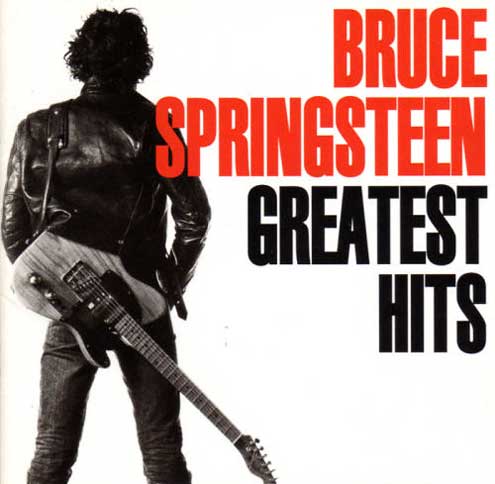
Greatest Hits (1995)
The cover of the 1995’s misnamed Greatest Hits (it’s neither a strict assembly of Springsteen’s best songs nor his chartologically-determined most popular) looks like a hyrbid of the cover for Bruce’s two monster Born albums, . . . to Run and . . . in the U.S.A. In fact, the shot is one of the 899 other photos Eric Meola shot at the Born to Run cover session in 1975. But there’s no Clarence, even though the E Street Band are present on 15 of the 18 songs included. Two long-requested Born in the U.S.A. outtakes, “Murder Incorporated” and “This Hard Land,” finally see the light of day here (though “Light of Day” does not).
“Murder Incorporated” was released as a single in 1995 (with a Jonathan Demme video) and performed at every show on the 1999-2000 tour. And the latter? Only one of the most joyous Springsteen songs ever. Anyway, pretty good cover. Rumors swirled of a 1995 tour with the E Street Band, but other than a few video shoots and an appearance at the opening concert for the Rock and Roll Hall of Fame that year, the E Street train would remain stuck in the station for almost another half-decade. The fact that this image looks like it could be a scarecrow Springsteen, a Bruceelganger if you will, is pitch-perfect (if accidentally so) reflection of where Bruce was at this point in his career: struggling to break free of his own myth and to make trenchant new music — with his old pals and without them.
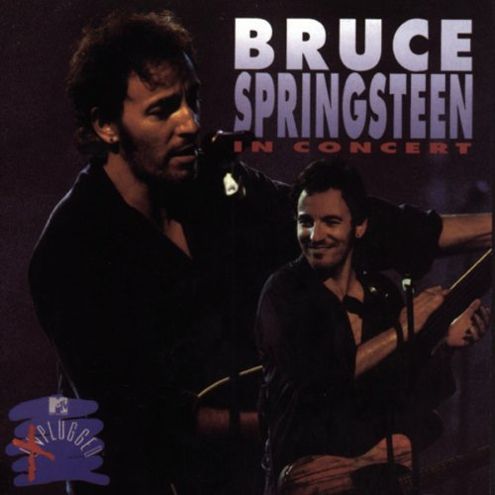
Plugged (1993)
Yeah, so Bruce showed up to tape a concert for MTV’s popular “Unplugged” series and plugged in after one song. The sole acoustic number was the previously unheard “Red-Headed Woman,” the first Springsteen track I can think of with a cunnlingus reference — and he’s totally talking about his wife! (Springsteen and the carrot-topped Scialfa married in 1991, when Scialfa was pregnant with their second child.) The show was a mixed bag, redeeming some of the Human Touch numbers from their limp studio incarnations and presenting some E Street-era classics like “Darkness on the Edge of Town” and “Atlantic City” in exciting new ways. Plugged also contained a performance of the 80s leftover “Light of Day,” and it smokes.
The cover seems like another, probably unintentional, summation of Bruce’s confusion during this period. Two Bruces, looking in opposite directions? From this picture, you’d think them album had failed to synthesize Pre and Post-Breakup Bruce rather than (largely) succeeded. Most bootlegs look better than this. Embarrassing.
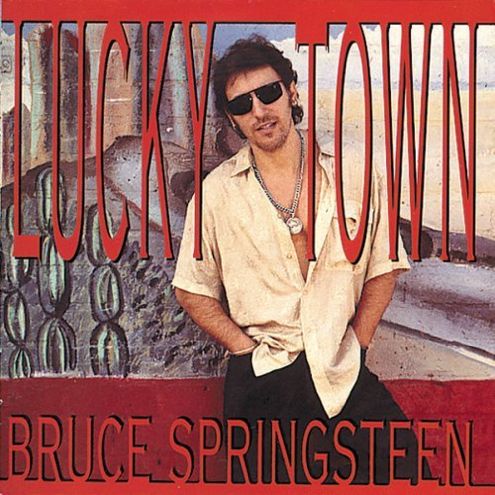
Lucky Town (1992)
Ladies and Gentlemen, short-lived Latin hip-hop star Gerardo! Does Bruce not have a wardrobe person on staff? Or a graphic designer? Does Columbia Records? The unbuttoned-shirt thing is a matter of taste, but those sunglasses? Clearly, Bruce had no one to tell him “no” by this point in his career.
Lucky Town happened when Bruce returned to the studio near the tail end of the meandering 18 months of sessions that begat Human Touch to record one final track. He came up with the fantastic “Living Proof,” and producer/manager/svengali Jon Landau told him to keep writing. Thus the 10 songs on this album were all conceived and executed in a few weeks, and show no sign of the limpness and uncertainty of the Human Touch stuff. The decision to release those two albums on the same day in the spring of 1992 is second only to the formal dismissal of the E Street Band as the dumbest call Springsteen and Landau ever made. Lucky Town is actually quite good — better than you think, anyway — not that you’d ever be moved to give it a chance if you happened to catch sight of its cover in one of the countless used CD bins it has inhabited for 15 years.
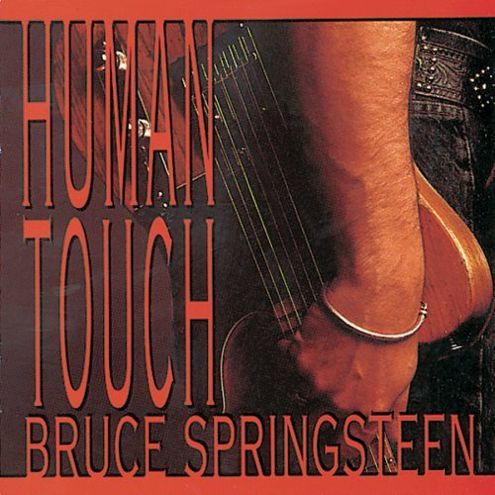
Human Touch (1992)
The knee-jerk aversion I have to this cover has nothing to do with its base aesthetic properties. I love the idea of Bruce making solo albums (like Nebraska), or albums outside of his usual idiom with non-E Street players (like The Seeger Sessions). But an album in the E Street style, that could have benefitted from the presence of the E Street band, made without them? Heresy. That’s all this cover makes me think about. Admittedly, it’s more semiotic weight than this boring image of a vaguely gypsyish, studded-belt and bracelet-wearing cat holding a guitar, can possibly bear. Hate is not a rational emotion. But I hate this cover, along with about 70 percent of the album.
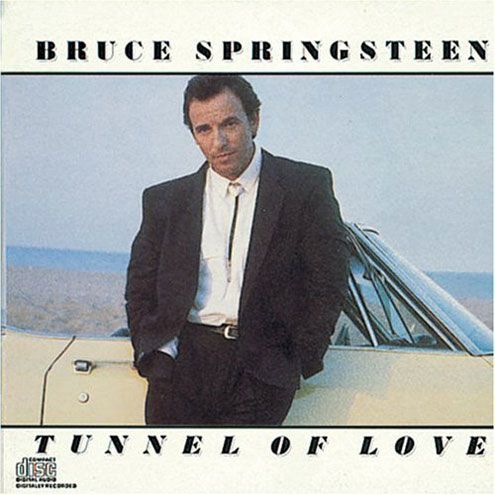
Tunnel of Love (1987)
Troubling: Bruce’s last beginning-to-end brilliant album is more than 20 years old. Born in the U.S.A. was the unstoppable singles machine, but its 1987 follow-up, taking on the mysteries of fidelity, is a stronger, more cohesive album. (Its release prefigured Bruce’s separation from his first wife, Julianne Phillips, by a matter of months.) Annie Leibovitz shot the cover, once again, and once again, it’s just about perfect. Bruce looks like he’s arriving to take you on a date on this, the first cover for which he appears to have showered, combed his hair, and donned clean clothes. The bolo tie clues you in that things might be a bit different from what you’re expecting. This is appropriate, in that this is an album entirely concerned with romantic relationships, and while the E Street Band is here, they’re present in a more subdued role than before. Newly ascendant are the synthesizers that date the album and have prevented it from getting its due , even though the album did win Album of the Year in Rolling Stone‘s 1987 critics poll, beating out even The Joshua Tree, U2’s very own Born to Run.
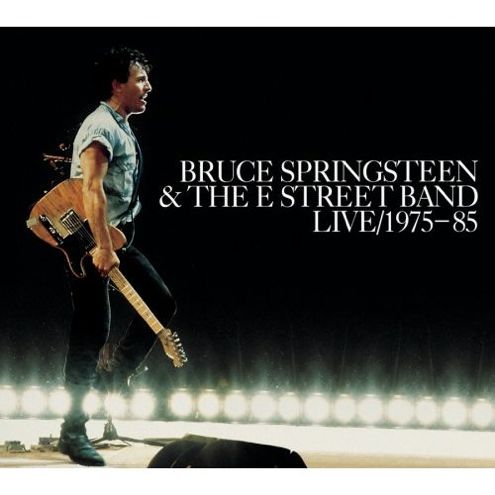 Live 1975-85 (1986)
Live 1975-85 (1986)
The only album in the canon credited to Bruce Springsteen and the E Street Band. Bruce is in a funny pose in this photo, lifting his left leg slightly like a dog visiting an unfamiliar tree. Is he walking forward? Is he preparing to do the crane kick that allows poor, wounded Daniel LaRusso to put down “Sweep the Leg” Johnny at the end of The Karate Kid? (“One of 1984’s best movies,” raved Roger Ebert.) Despite this, it’s a great, even iconic image of Bruce staring out into the fog of the audience, blinded by the footlights — and by the sheer exhilaration of being probably three-and-a-quarter-hours into a three-and-a-half hour performance at, say, the the Roxy, where nearly a quarter of the album’s 40 songs were tracked. I’ve always imagined that this cover is, in effect, the video for “Raise Your Hand” (track 11 on disc three), wherein he stops mid-song to chide the crowd for not cheering fervently enough: “Do you think this is a free ride?” The Boss demands. “You want to play, you got to pay!”
The album was originally released as five vinyl albums, but by the time I got around to it in the mid-90s, it was available as a three-CD set. Live 1975-1985 remains the second best-selling live album ever in the U.S., behind Garth Brooks’ Double Live. Garth is an even commoner common man, it would seem. Maybe if Bruce had had Garth’s saavy, he’d have called his album Triple Live on CD or Quintiple Live on vinyl. Then, perhaps, the crown would still be his.
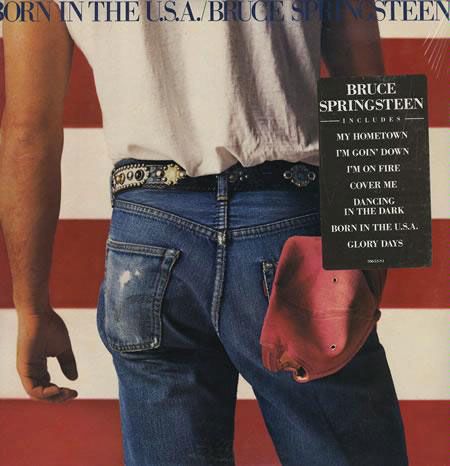
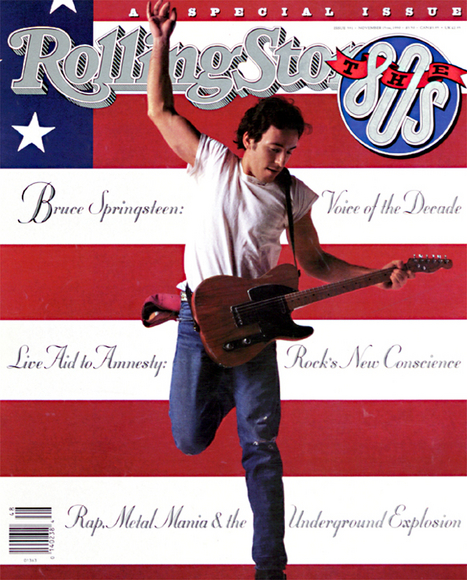
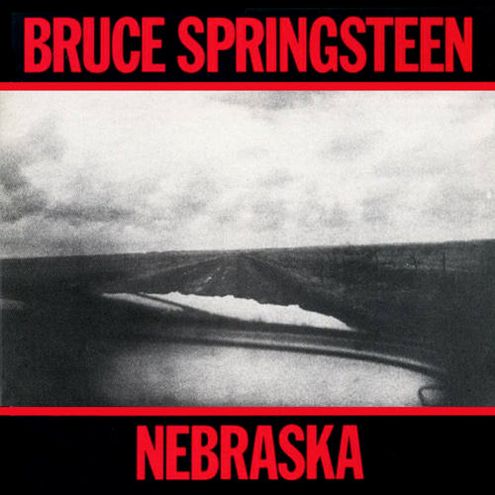
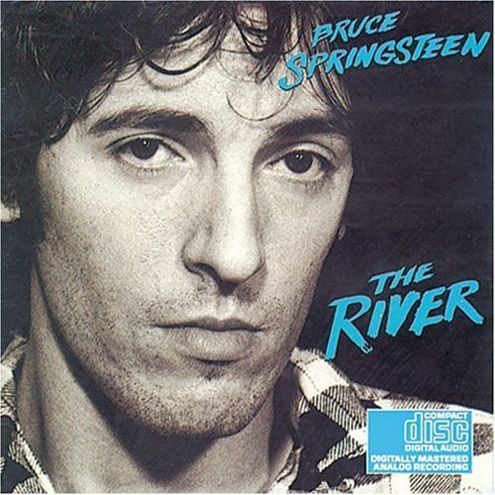
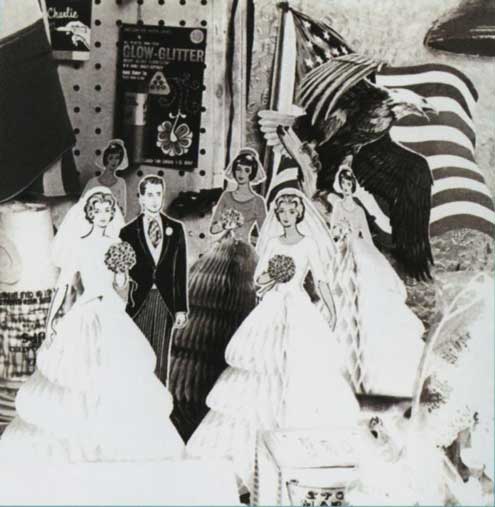
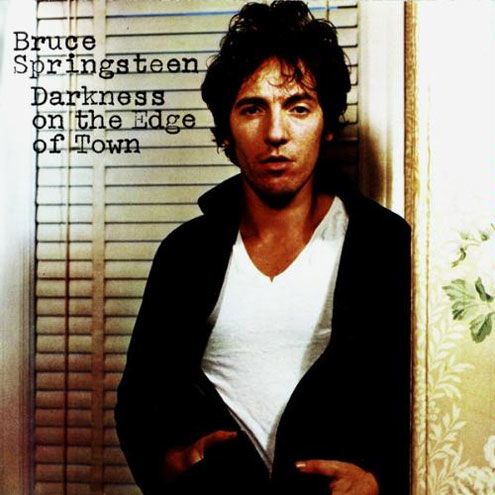
Yeah, he looks like he went and knocked up Mary, all right. Oh, wait, wrong album. Born to Run may have been all about the fantasy of “pulling out of here to win,” but the guy on the front of Darkness on the Edge of Town — released three years and one protracted legal battle with former manager Mike Appel after Born to Run — sure looks like he’s settled in the “town full of losers” referenced in “Thunder Road.”
This is the cover my Bruce-loving friends and I have most often cited as evidence of Bruce’s poor taste in choosing album covers, but in retrospect, this image is a pretty good representation of the dark turn Bruce’s writing takes on this album. The street operettas like “Backstreets” and “Jungleland” are done now, not to reappear for three decades. (Working on a Dream makes an awkward attempt to revive this aspect of Springsteen’s legacy.) So this one gets its own special award: Most Improved!
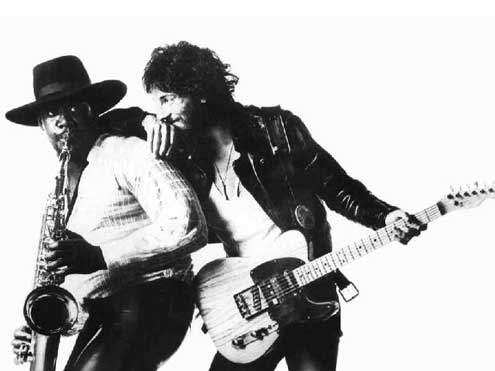
Born to Run (1975)
So it was 1987 or 1988, and it must have been the Friday before a school vacation or something, because Mr. B., the teacher I and everyone else in m sixth-grade class at Oak Hill Elementary just adored, was playing the radio in the classroom. And this corny song comes on with this goofy saxophone vamp, and I start singing along for the amusement of my friends: “Doo-wop, shoo-be-do! Doo-wop, shoo-be-do!” And Mr. B — ordinarily a cool car, patient and unflappable — gets flushed like I I’ve never seen him, and demands, “Chris, do you know who that is you’re making fun of?” He was really mad.
And I’d be mad too, nowadays, if I was grooving out to “Tenth Avenue Freeze-Out” from Born to Run, the kingmaking album of Bruce Springsteen’s career, and some chubby little 11-year-old know-it-all started shoo-be-doo-ing along.
The funny thing is, I knew who Bruce Springsteen was then. We had MTV at my house. I had Bruce’s other Born album, . . . in the U.S.A., on cassette. And when Mr. B told me I was mocking Bruce Springsteen — the man who wrote “Glory Days!” — I was crushed. Secretly. I kept making fun of “Tenth Avenue Freeze-Out” in a hapless attempt to save face, but my heart wasn’t in it.
Anyway, Born to Run is where the Springsteen myth reached its cruising altitde, and part of that legend is the Band of Brothers that he would 30 years later refer to as the “hip-shakin’, history-makin’, booty-quakin’, viagara-takin’ E Street Band.” “Tenth Avenue Freeze Out” is the creation myth — “Well there came a change uptown, and a big man joined the band” — and this album cover, of Bruce leaning on Clarence’s shoulder, is part of that myth, too.
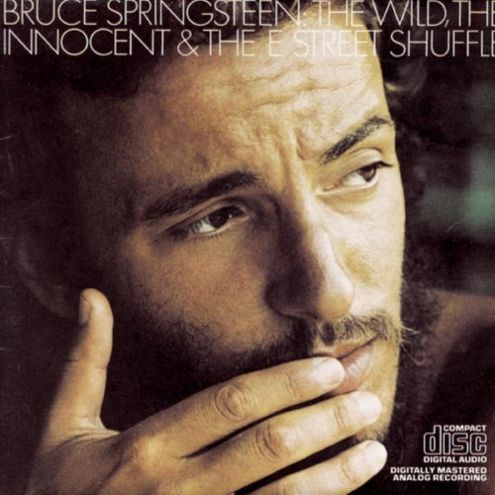
The Wild, the Innocent, and the E Street Shuffle (1973)
The album is a staggering progression from the folky Greetings, though it came only eight months later. The cover photo becomes more meaningful as the years wear on because of how shaggy and hippie-ish the 23-year-old Bruce looks. But I’m not sure what this photo might have expressed upon the album’s initial release, other than that facial hair isn’t for everyone.
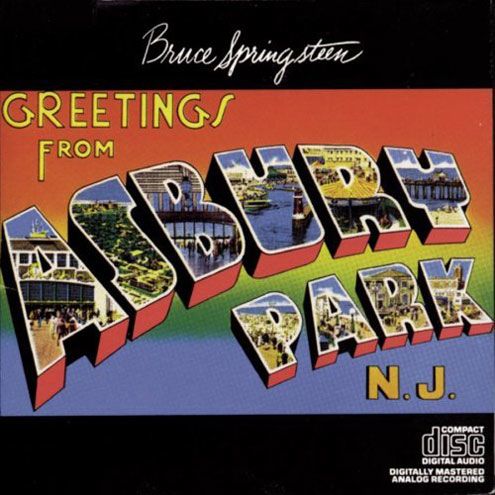
Madman drummers bummers and Indians in the summer with a teenage diplomat! Or something!
I’ve always liked the postcard motif cover of Bruce’s debut, released in the first week of 1973, the year of Bowie’s Aladdin Sane. Who ever heard of Asbury Park before they heard of Bruce Springsteen? Bruce’s romanticization of the boardwalk and the nobodies who populate it would get more evocative and specific not much later, but it all begins here, as the title and the cover image portend.

Great piece. The Working on a Dream cover is truly a nightmare, although I’ll defend Tom Joad by saying I thought it was awesome 13 years ago. Hasn’t aged well.
Also worth noting: the obviously stock photo cover and problematic metaphorical potential for Wal-Mart’s exclusive Greatest Hits: http://www.walmart.com/catalog/detail.gsp?image=http://i.walmartimages.com/i/p/00/88/69/74/39/0088697439302_500X500.jpg&product_id=10811413&iIndex=1&isVariant=false&corpCard=false&type=0
Is that John Cusack on the cover of The Rising?
Loved this analysis. Excellent work.
I wrote a similar piece (much shorter, not as well-argued as yours) and posted it literally 10 minutes before the Vulture blog linked to this one. Anyway, consider this an apology for inadvertently stepping on your toes. I posted a link to this piece in the comment section of mine. Yours is much better.
Pingback: …in which McNutt questions Bruce Springsteen’s partnership with Brendan O’Brien « McNutt Against the Music
The only album in the cannon? You keep your records in a big gun?
I think I’m the only person in the world who enjoys Human Touch. “I Wish I Were Blind” is one of Bruce’s best songs, and there ain’t nothing wrong with “man’s Job” or “57 Channels.” Some of the songs are fairly limp, but I don’t find the album an egregious affront to musicality, as most die hard Bossites seem to.
But then, I’m a Dylan man myself.
Blind is a song we can all relate to.
great work!
and human touch album and song rocks, especially that Plugged version…
You make good points, and bravo.
I hate everything after Darkness (although I love that cover, and the fact that Bruce went to the printing plant at 1 in the morning to supervise the print run because he didn’t like the way the cover had been coming out counts for a lot), and all of his concert merch is similiarly horrific. I mean, okay, so you have no taste. HIRE SOMEONE WHO DOES.
The worst offender of this was the imagery for the Reunion tour – it looks like someone threw up on the cover of BTR, scanned it, put it through a blur filter in Photoshop, and said “here”.
No I can’t believe this! That man can do no wrong in my eyes – I love every single cover – because behind each one there are the most amazing lyrics, the most outrageously beautiful music and probably the most talented man in the world…. *sigh* okay… okay one or two might be a little questionable but… I appreciate your thoughts… though… who looks at the darn things anyway? You’re just eager to pull the CD out and listen to the man!
How true.
Pingback: Ouch! Springsteen wins dubious honor for cover art : Blogness on the Edge of Town
I enjoyed and agreed with much you had to say, but speaking for millions of women all over the world, I guarantee you that Bruce did not have a short run as a sex symbol. He is, was, and always will be the hottest rock and roller ever. Totally unbiased, of course.
bruce is as hot today as he was in the 80s. totally in love with this man
Really the only decent covers are the first four -Greetings,Wild, Born to Run & Darkness. From That point on the artwork took a backseat to the “image” of what Springsteen had become (based largely on Born to Run and his marathon live shows,) a megastar every-man. Part of the blame should also lay with Columbia records “art department.” They have been issuing ugly covers for what seems like forever. Dylan has a few iconic covers but, like Bruce, the majority are hideous, As are many of Leonard Cohens. Sony (Columbia & It’s associated labels) especially dropped the ball with the advent of CD’s. While CEMA (Capitol & associated) and WEA (Warner’s, Elektra, Atlantic and Rhino, at the time) understood how to repackage and re-release catalog titles on compact disc, including copious liner notes and often improved artwork in ADDITION to the original art, Sony/Columbia (and to a certain extent BMG/RCA) just gave you blank inner cards and idiotic “fold downs” of the original LP size artwork. Certainly there were some exclusions but I have never seen such MAJOR artists be so ill-served by their labels, in packaging as well as remastering. That said it does seem as if Springsteen has little care for what his releases look like. Certainly from Nebraska on the artwork for Springsteen’s releases could be interchangeable with each other and not seem incongruous. Oh Yeah, Sony/Columbia also put that totally unnecessary Compact Disc logo on the corner of the front art on all their CD releases for YEARS! as if adding UPC codes (not just Sony but pretty much all products of any kind) to the back cover a few years before wasn’t bad enough.